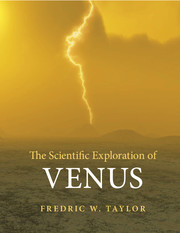Book contents
- Frontmatter
- Contents
- Overview
- Prologue
- A note on scientific units
- Acknowledgements
- Part I Views of Venus, from the beginning to the present day
- Part II The motivation to continue the quest
- Chapter 9 Origin and evolution
- Chapter 10 Atmosphere and ocean
- Chapter 11 A volcanic world
- Chapter 12 The mysterious clouds
- Chapter 13 Superwinds and polar vortices
- Chapter 14 The climate on Venus, past, present and future
- Chapter 15 Could there be life on Venus?
- Part III Plans and visions for the future
- Epilogue
- References and acknowledgements
- Appendix A Chronology of space missions to Venus
- Appendix B Data about Venus
- Index
- Plate section
Chapter 12 - The mysterious clouds
from Part II - The motivation to continue the quest
Published online by Cambridge University Press: 05 September 2014
- Frontmatter
- Contents
- Overview
- Prologue
- A note on scientific units
- Acknowledgements
- Part I Views of Venus, from the beginning to the present day
- Part II The motivation to continue the quest
- Chapter 9 Origin and evolution
- Chapter 10 Atmosphere and ocean
- Chapter 11 A volcanic world
- Chapter 12 The mysterious clouds
- Chapter 13 Superwinds and polar vortices
- Chapter 14 The climate on Venus, past, present and future
- Chapter 15 Could there be life on Venus?
- Part III Plans and visions for the future
- Epilogue
- References and acknowledgements
- Appendix A Chronology of space missions to Venus
- Appendix B Data about Venus
- Index
- Plate section
Summary
Centuries of speculation about the nature of the clouds on Venus, and many theories and guesses about their composition, some quite exotic, finally led to the definite identification of concentrated sulphuric acid in the 1970s. The clouds were considered likely to have a quite simple vertical and global structure because they looked so featureless through a telescope. Now that they have been studied and analysed, from Earth, from orbit, and by probes parachuting through them, are they still ‘mysterious’?
Yes, for a number of reasons. Consider some of the problems we are still pondering:
The clouds form distinct layers. What produces this vertical structure? How much does it vary, across the planet and in time, and what produces the variations?
Only the higher layers are ‘definitely’ composed of sulphuric acid. The clouds form layers over a range of depths in the atmosphere, and there is evidence that the deeper layers have some different composition, possibly solid particles.
Even the higher layers have impurities mixed in them that we have not yet identified, including the absorber that gives rise to the dark ultraviolet markings. Some sort of variable chemistry is going on, producing localised concentrations and patterns of absorber.
The horizontal structure in the upper cloud layer is produced by waves and by weather that can be at least partially understood through its resemblance to terrestrial meteorology. But the deep cloud also shows dramatic, variable contrasts, and these have a different character. Before these were discovered, they would not have been expected at all, let alone on such a dramatic scale, and the mechanism responsible is still unclear. In Chapter 11 we suggested that they could be dust plumes from erupting volcanoes, but this is not yet confirmed.
As on Earth, the clouds on Venus are a central part of a hydrological cycle of evaporation, condensation and precipitation that is at the heart of a highly interactive climate system. Any variation in cloud density or distribution is going to be linked to changes in the energy balance in the atmosphere, and any long-term changes will affect the atmospheric ‘greenhouse’ and the surface temperature. We need to understand this in detail.
There is still a lot to do then. Let’s see how these puzzles fit with what we already know.
- Type
- Chapter
- Information
- The Scientific Exploration of Venus , pp. 182 - 196Publisher: Cambridge University PressPrint publication year: 2014



